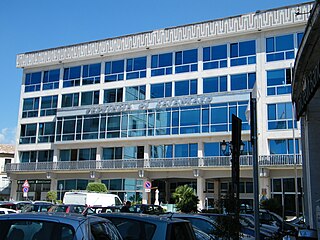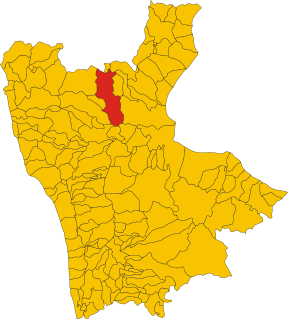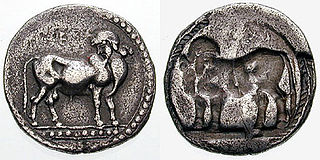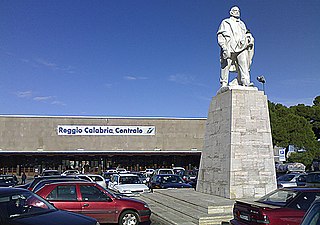
Calabria, is a region in Southern Italy. It is bordered by Basilicata to the north, the Gulf of Taranto to the east, the Ionian Sea to the south, the Strait of Messina to the southwest, which separates it from Sicily, and the Tyrrhenian Sea to the west. With almost 2 million residents across a total area of approximately 15,222 square kilometres (5,877 sq mi), it is the tenth populous and the tenth-largest Italian region by area. Catanzaro is the region's capital, while Reggio Calabria is the most populous city in the region. Calabria is the 14th most productive region in the country. The Pollino National Park with 192,565 ha is the largest national park in the country and ranks among the 50 largest in the world.
Reggio di Calabria, usually referred to as Reggio Calabria, or simply Reggio by its inhabitants, is the largest city in Calabria. It has an estimated population of nearly 200,000 and is the twenty-first most populous city in Italy, after Modena, and the 100th most populated city in Europe. Reggio Calabria is located in the exact center of the Mediterranean and is known for its climate, ethnic and cultural diversity. It is the third economic centre of mainland Southern Italy. About 560,000 people live in the metropolitan area, recognised in 2015 by Italian Republic as a metropolitan city.

The 'Ndrangheta is a prominent Italian Mafia-type organized crime syndicate and criminal society based in the peninsular and mountainous region of Calabria and dating back to the late 18th century. It is considered to be among the most powerful organized crime groups in the world. Since the 1950s, following wide-scale emigration from Calabria, the organization has established itself worldwide. The 'Ndrangheta is the only one of the mafia-type criminal organizations operating in Italy to have maintained the rites that distinguished it in the past, passing them down orally and through codes that, on rare occasions, have been discovered. It is characterized by a horizontal structure made up of autonomous clans known as 'ndrine, based almost exclusively on blood ties. Its main activity is drug trafficking, of which it has a monopoly in Europe, but it also deals with arms trafficking, money laundering, racketeering, extortion, loan sharking, and prostitution. The 'Ndrangheta has enjoyed, for decades, a privileged relationship with the main South American drug cartels, which consider it the most reliable European partner. It is capable of heavily influencing local and national politics and infiltrating large sectors of the legal economy. In 2013 they purportedly made €53 billion according to a study from Demoskopika Research Institute. A US diplomat estimated that the organization's narcotics trafficking, extortion and money laundering activities accounted for at least three per cent of Italy's GDP in 2010.

Magna Graecia was the name given by the Romans to the coastal areas of Southern Italy in the present-day regions of Calabria, Apulia, Basilicata and Campania; these regions were extensively populated by Greek settlers. These settlers, who began arriving in the 8th century BC, brought with them their Hellenic civilization, which left a lasting imprint in those territories, as it did in the culture of ancient Rome. They also influenced the native peoples, such as the Sicels, or the Oenotrians, who became Hellenised after they adopted the Greek culture as their own.

Reggina 1914 S.r.l., commonly referred to as Reggina, is an Italian football club based in Reggio Calabria. Founded in 1914, they currently play in Serie B, and play their home matches at the 27,763 seater Stadio Oreste Granillo.

Griko, sometimes spelled Grico, is the dialect of Italiot Greek spoken by Griko people in Salento and in Calabria. Some Greek linguists consider it to be a Modern Greek dialect and often call it Katoitaliótika or Grekanika (Γραικάνικα), whereas its own speakers call it Greko or Griko. Griko is spoken in Salento while Greko is spoken in Calabria. Griko and Standard Modern Greek are partially mutually intelligible.

Catanzaro, also known as the "City of the two Seas", is an Italian city of 91,000 inhabitants (2013), the capital of the Calabria region and of its province and the second most populated comune of the region, behind Reggio Calabria.

The province of Catanzaro is a province of the Calabria region of Italy. The city Catanzaro is both capital of the province and capital of the region of Calabria. The province contains a total of 80 municipalities (comuni). Its provincial president is Sergio Abramo.

The Province of Reggio Calabria was a province in the Calabria region of Italy. It was the southernmost province in mainland Italy and is separated from the island of Sicily by the Strait of Messina. The capital was the city of Reggio.
The primary languages of Calabria are the standard Italian language as well as regional varieties of the Neapolitan and Sicilian languages, all collectively known as Calabrian. In addition, there are 100,000 Arbëresh-Albanian speakers, as well as small numbers of Calabrian Greek speakers and pockets of Occitan.

Reggio di Calabria "Tito Minniti" Airport, also known as Aeroporto dello Stretto is an airport located in Reggio Calabria, in southern Italy. It serves mainly the Province of Reggio and the Province of Messina, and partially the Province of Vibo Valentia; more than 1,350,000 people. Daily flights depart and arrive for and from several Italian cities, and are seasonally augmented by flights to various other countries.

Castrovillari is a town and comune in the province of Cosenza in the Calabria region of southern Italy.

Laüs or Laus was an ancient city of Magna Graecia on the coast of the Tyrrhenian Sea. It was a colony of Sybaris at the mouth of the Lao River, which formed the boundary between Lucania and Bruttium in ancient times. The river and the city have the same name in Ancient Greek. Today the archaeological site of the city can be found at a short distance to the east of Marcellina, a frazione of the comune of Santa Maria del Cedro in Calabria.

Viola Reggio Calabria was an Italian professional basketball club based in Reggio Calabria, Calabria.

Calabrian wine is Italian wine from the Calabria region of southern Italy. Over 90% of the region's wine production is red wine, with a large portion made from the Gaglioppo grape. Calabria has 12 Denominazione di origine controllata (DOC) regions, but only 4% of the yearly production is classified as DOC wine. The region is one of Italy's most rural and least industrialized with per capita income less than half of the national average. Following World War II, many of Calabria's inhabitants emigrated to Northern Italy, the United States, Australia and Argentina. Those left behind have been slow to develop a vibrant wine industry with only the red wines of Cirò garnering much international attention. Today Calabrian wines are mostly produced to high alcohol levels and sold to co-operatives who transfer the wines to the northern Italian wine regions to use as blending component. There are no Denominazione di Origine Controllata e Garantita (DOCG) regions, but Calabria does have 12 Indicazione Geografica Tipica (IGT) designations.

The County of Apulia and Calabria, later the Duchy of Apulia and Calabria, was a Norman state founded by William of Hauteville in 1042 in the territories of Gargano, Capitanata, Apulia, Vulture, and most of Campania. It became a duchy when Robert Guiscard was raised to the rank of duke by Pope Nicholas II in 1059.

Reggio di Calabria Centrale railway station is the main railway station of the Italian city of Reggio Calabria in Calabria. It is the most important station of its region and is owned by the Ferrovie dello Stato, the national rail company of Italy.
Davide Calabria is an Italian professional footballer who plays as a full-back for the Serie A club Milan and the Italy national team.

Metropolitan City of Reggio Calabria is an area of local government at the level of metropolitan city in the Calabria region of the Republic of Italy. It comprises the territory of the city of Reggio Calabria and 97 other municipalities (comuni) in the hinterland of the city. With more than 600,000 inhabitants, it is one of the main metropolitan areas. It replaced the Province of Reggio Calabria in 2017.


















